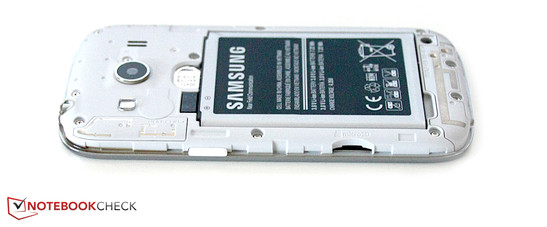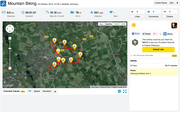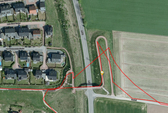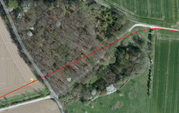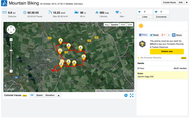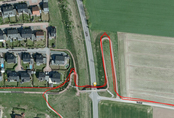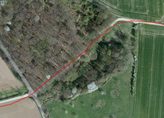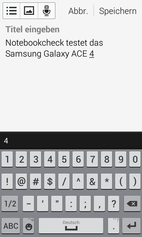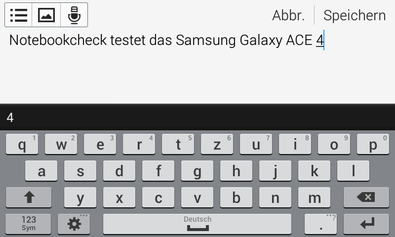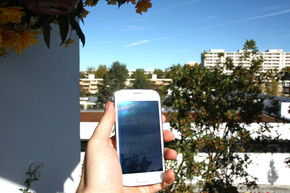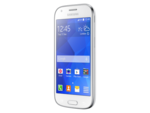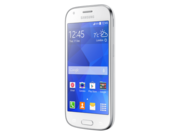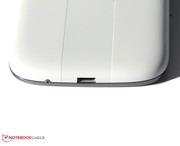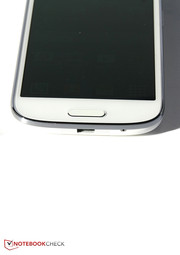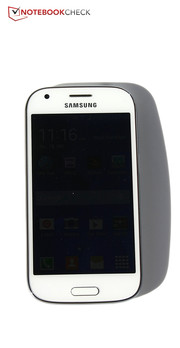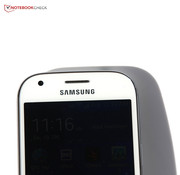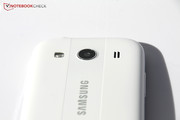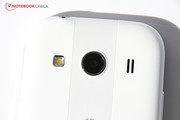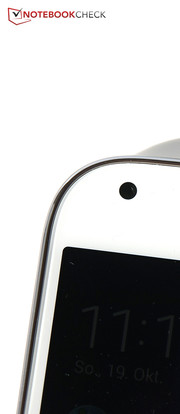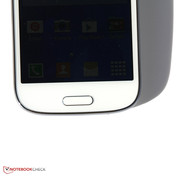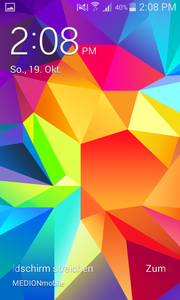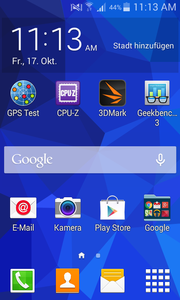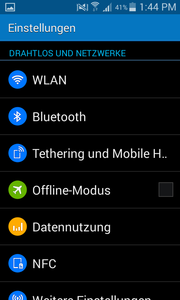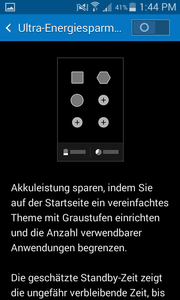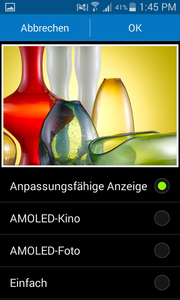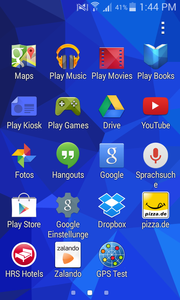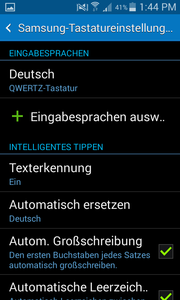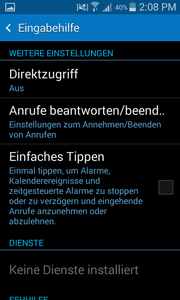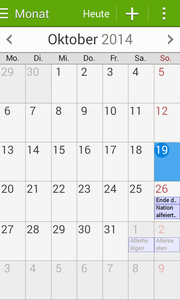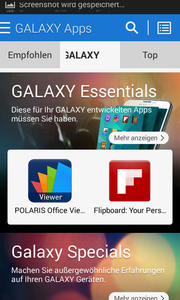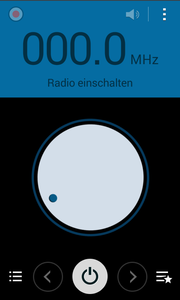Samsung Galaxy Ace 4 SM-G357FZ Smartphone Review

For the original German review, see here.
We really liked the Galaxy Ace 3. The high build quality and the bright display were only two of the positive aspects. Now Samsung offers its successor, which is consequently called Samsung Galaxy Ace 4. The smartphone is now cheaper because the competition offers less expensive entry-level devices as well. Slightly thinner, a slightly larger battery, a textured back cover, but otherwise the changes are small. Is that enough for a good performance in the entry-level segment?
This segment is actually pretty crowded: For less than 200 Euros (~$250), and with 5-inch displays you can get the HTC Desire 510, Desire 310, LG L70, Nokia Lumia 630, Motorola Moto G, Sony Xperia E1 or the Huawei Ascend Y530.
Case
The Samsung Galaxy Ace 4 basically has not changed compared to its predecessor. The standby button is now at a lower position, otherwise you can only see a difference when you look at the back: The back cover now has a textured stripe. This improves the grip and feels convenient. There is an additional silver manufacturer's logo for a sophisticated quality look. Speaker and flash have switched places and the camera is not squared with rounded edges anymore, but is round.
The case design still has rounded edges and a silver frame, which results in a sophisticated look. The color choice is limited to dark gray and white. The stability is very good: Pressure on the front and back does not result in picture distortions. You can still remove the back cover, which gives you access to the SD slot, SIM slot and the replaceable battery.
The device is now even thinner than its predecessor at 9.1 millimeters (~0.36 inches), but the Samsung Galaxy Ace 4 is slightly heavier than the Ace 3: The smartphone weighs 126 grams (~4.4 ounces).
Connectivity
The differences of the connectivity with its predecessor basically concern the SoC and the integrated graphics solution. The other specifications are identical: 1 GB of memory, 8 GB of storage, a micro USB 2.0 port at the bottom and a combined stereo jack at the top. You can get access to the micro SIM slot and the micro SD slot after you remove the back cover.
Software
The operating system was updated to Android 4.4, and like every other Galaxy model, you get the TouchWiz user interface. The latter is intuitive to operate, and offers numerous new or extended features, even though they are not as comprehensive compared to the more expensive Galaxy versions. At least you can still choose between different modes for the picture, there are numerous assistants for visually and hearing impaired users and the excellent ultra energy-saving mode, which can manage good runtimes with a weak battery.
Samsung does not include many apps, but you get several preinstalled apps from online shops, at least you can remove them without any problems.
Communication & GPS
The Galaxy Ace 4 is even more versatile with regard to connectivity than its predecessor. The latter already supported the fast LTE standard, and this has not changed in the successor. All mobile standards now support more bands, so you can make calls and browse the web in more countries all over the world. The transfer rates of the LTE module now meet the Cat. 4 standard, with up to 150 Mbps downstream and up to 50 Mbps upstream.
The WLAN module can establish a connection with 802.11 b/g/n networks. The signal quality with a distance of ten meters (~33 ft), and through three walls is average: The indicator varies between 3/4 and 1/2. Another two meters (~6.5 ft), and another wall, result in 1/4 up to 1/2, but web pages are already loaded noticeably slower. Another highlight of the Ace 4 is NFC, which can be used to establish connections to other devices in close proximity.
The GPS module also works with the Russian GLONASS network. It does find some satellites indoors, but the signal is too weak to locate our position. It only takes a couple of seconds before the first satellites are found outdoors, and our position is quickly located down to three meters (~9.8 ft).
We want to check the performance and take the smartphone on a bicycle ride in the forest. We use the professional navigation device Garmin Edge 500 for a comparison. The Galaxy Ace 4 shows 400 meters less (~1312 ft) for the complete track, and the location dropped out at the bridge crossing, so it seems we are flying above the crossing street. The position in the forest is not correct, either.
Telephone Functions and Voice Quality
The phone app is visually modified, but it is very similar to the standard Google app in terms of functions. You can add favorites and combine contacts in groups. Overall, this is pretty intuitive.
The voice quality is okay, but the other person complained about a slightly muffled sound and hissing sounds. The voice on our end is slightly tinny as well, and not as clear as high-end smartphones. The playback via the integrated speaker is good: The maximum volume is high, and the sound is clear.
Cameras & Multimedia
Like its predecessor, the camera has a resolution of 5 megapixels, but the front camera has received a small update to 1.3 megapixels. Now it is at least suited for fast selfies if you do not expect a very high quality.
Taking photos with the camera at the back, results in pretty average pictures, which shows the potential for improvement with regard to the depth of field and color reproduction in particular. The auto-focus is pretty slow too.
At least the software offers some modes like continuous shooting, panoramas or even a night mode. The latter brightens up the picture without the flash, but the exposure time is increased, which means you have to hold the smartphone very still to get a sharp picture. We did not manage that, despite several attempts. Full HD videos cannot be recorded, the highest possible resolution is 1,280x720 pixels and the quality is decent.
Accessories
Samsung provides a headset, a USB cable and a power adaptor with a permanently installed cable. This obviously has the disadvantage that you do not necessarily have a USB cable if you take the power adaptor with you and you have to think of two parts. Special accessories for the Galaxy Ace 4 are not available.
Warranty
Samsung offers a 24-month warranty for its smartphone.
Input Devices & Handling
We already know the virtual keyboard from other Galaxy devices; it has a simple and clear layout with sufficient spacing between the individual keys. You can only access the numbers if you switch to the symbols. Another option is to swipe over the keyboard and you can then dictate via Google's voice input. Overall, the handling of the keyboard is reliable both in landscape and portrait mode.
The touchscreen supports inputs of up to 10 fingers simultaneously. It is precise up into the peripheral areas and does not have problems with multi-touch gestures. However, a very sensitive mode, which would allow the handling with gloves in the winter, is not available.
Display
Look at the display, and you can quickly see a big difference with the Galaxy Ace 3: The successor is equipped with an AMOLED display, while the predecessor still used a standard LCD panel. However, the resolution has not changed: 800x480 pixels are still the maximum. This can result in slightly frayed fonts and the overall picture is not as sharp compared to higher-resolution screens. Still, the sharpness of the display is adequate.
AMOLED displays are known for rich colors and an infinite contrast ratio, because black pixels are actually not illuminated. LCD panels on the other hand, usually have an advantage in terms of brightness, which is the case here: The Galaxy Ace 4 only manages an average brightness of 339.2 cd/m² and therefore occupies the last place within our comparison. The brightness distribution is at least very even with 92%.
| |||||||||||||||||||||||||
Brightness Distribution: 92 %
Center on Battery: 336 cd/m²
Contrast: ∞:1 (Black: 0 cd/m²)
ΔE ColorChecker Calman: 5.19 | ∀{0.5-29.43 Ø4.77}
ΔE Greyscale Calman: 3.75 | ∀{0.09-98 Ø5}
Gamma: 2.36
CCT: 7152 K
| Samsung Galaxy Ace 4 SM-G357FZ Adreno 306, 410 MSM8916, 8 GB SSD | Samsung Galaxy Ace 3 GT-S7275R Adreno 305, S4 Plus MSM8930, 8 GB SSD | HTC Desire 510 Adreno 306, 410 MSM8916, 8 GB SSD | LG L70 Adreno 302, 200 8210, 4 GB Flash | Nokia Lumia 630 Adreno 305, 400 MSM8226, 8 GB eMMC Flash | Motorola Moto G 1. Gen XT1032 Adreno 305, 400 MSM8226, 8 GB SSD | |
|---|---|---|---|---|---|---|
| Screen | -22% | -85% | -27% | -16% | -1% | |
| Brightness middle (cd/m²) | 336 | 458 36% | 355 6% | 346 3% | 355 6% | 441 31% |
| Brightness (cd/m²) | 339 | 430 27% | 371 9% | 339 0% | 350 3% | 417 23% |
| Brightness Distribution (%) | 92 | 86 -7% | 80 -13% | 91 -1% | 91 -1% | 89 -3% |
| Black Level * (cd/m²) | 0.49 | 0.37 | 0.52 | 0.73 | 0.54 | |
| Colorchecker dE 2000 * | 5.19 | 7.02 -35% | 12.13 -134% | 7.17 -38% | 7.19 -39% | 4.83 7% |
| Greyscale dE 2000 * | 3.75 | 8.63 -130% | 14.77 -294% | 7.42 -98% | 5.63 -50% | 6.2 -65% |
| Gamma | 2.36 93% | 2.77 79% | 2.42 91% | 2.5 88% | 1.97 112% | 2.6 85% |
| CCT | 7152 91% | 7355 88% | 17097 38% | 10363 63% | 6293 103% | 8364 78% |
| Contrast (:1) | 935 | 959 | 665 | 486 | 817 |
* ... smaller is better
However, the AMOLED display actually scores with its contrast: In theory an infinite contrast ratio and a black value of 0.0 cd/m² make it possible. The results are glowing colors of the panel, and black areas really look like deep black without a gray film.
The color presentation compared to the reference color space sRGB is pretty precise, which we can determine with the software CalMAN and a special measuring device. You can only see a minimum blue cast with brighter shades of gray, the average DeltaE deviation of the grayscale from the ideal value is 3.75, which is a very small value compared with the rivals. Based on our experiences, you can reduce this value even further if you choose one of the other settings that Samsung provides. Colors are a bit too rich in the adaptive mode, but we actually like that. The colors are less saturated in the "Simple" mode.
Even though the colors are very bright on the panel, the maximum luminance of the display is limited. This, combined with the reflective surface, can make it tricky to use the smartphone under bright sunlight. Cloudy days on the other hand, are no problem for the Samsung Galaxy Ace 4, and using it in bright indoor environments is no problem, either.
Performance
The SoC of the Samsung Galaxy Ace 4 is called Qualcomm Snapdragon 410 MSM8916 and consists of a dual-core processor with a clock of 1.2 GHz. This SoC is also used inside the HTC Desire 510. It provides a 64-bit architecture and a much better per-MHz performance than the SoCs from the comparison devices.
This is also visible in the synthetic benchmarks, where the HTC Desire 510 is on a similar level, but the other devices fall behind significantly. The performance advantage over the predecessor is clearly noticeable, and is sometimes over 70%.
| Geekbench 3 | |
| 32 Bit Single-Core Score (sort by value) | |
| Samsung Galaxy Ace 4 SM-G357FZ | |
| Samsung Galaxy Ace 3 GT-S7275R | |
| HTC Desire 510 | |
| LG L70 | |
| Motorola Moto G 1. Gen XT1032 | |
| 32 Bit Multi-Core Score (sort by value) | |
| Samsung Galaxy Ace 4 SM-G357FZ | |
| Samsung Galaxy Ace 3 GT-S7275R | |
| HTC Desire 510 | |
| LG L70 | |
| Motorola Moto G 1. Gen XT1032 | |
| Smartbench 2012 | |
| Productivity Index (sort by value) | |
| Samsung Galaxy Ace 4 SM-G357FZ | |
| Samsung Galaxy Ace 3 GT-S7275R | |
| HTC Desire 510 | |
| Gaming Index (sort by value) | |
| Samsung Galaxy Ace 4 SM-G357FZ | |
| Samsung Galaxy Ace 3 GT-S7275R | |
| HTC Desire 510 | |
| AnTuTu v5 - Total Score (sort by value) | |
| Samsung Galaxy Ace 4 SM-G357FZ | |
| HTC Desire 510 | |
The situation is similar to the graphics solution Adreno 306, only the HTC Desire 510 with the same SoC can keep up. The other comparison devices clearly fall behind. We use the battery test of the benchmark GFX 3.0 to see if the SoC can maintain its performance over a longer period or if it throttles after prolonged periods of load: The GPU benchmark is repeated 30 times and the performance is monitored at the same time. The result of 15 frames per second is identical to a single run, so there should not be any problems with throttling under load. We also check the performance in different games in the section Gaming Performance.
| 3DMark | |
| 1280x720 offscreen Ice Storm Unlimited Score (sort by value) | |
| Samsung Galaxy Ace 4 SM-G357FZ | |
| HTC Desire 510 | |
| LG L70 | |
| Motorola Moto G 1. Gen XT1032 | |
| 1280x720 offscreen Ice Storm Unlimited Graphics Score (sort by value) | |
| Samsung Galaxy Ace 4 SM-G357FZ | |
| HTC Desire 510 | |
| LG L70 | |
| Motorola Moto G 1. Gen XT1032 | |
| 1280x720 offscreen Ice Storm Unlimited Physics (sort by value) | |
| Samsung Galaxy Ace 4 SM-G357FZ | |
| HTC Desire 510 | |
| LG L70 | |
| Motorola Moto G 1. Gen XT1032 | |
| GFXBench (DX / GLBenchmark) 2.7 | |
| T-Rex Onscreen (sort by value) | |
| Samsung Galaxy Ace 4 SM-G357FZ | |
| Samsung Galaxy Ace 3 GT-S7275R | |
| LG L70 | |
| Motorola Moto G 1. Gen XT1032 | |
| 1920x1080 T-Rex Offscreen (sort by value) | |
| Samsung Galaxy Ace 4 SM-G357FZ | |
| Samsung Galaxy Ace 3 GT-S7275R | |
| LG L70 | |
| Motorola Moto G 1. Gen XT1032 | |
| GFXBench 3.0 | |
| on screen Manhattan Onscreen OGL (sort by value) | |
| Samsung Galaxy Ace 4 SM-G357FZ | |
| HTC Desire 510 | |
| LG L70 | |
| 1920x1080 1080p Manhattan Offscreen (sort by value) | |
| Samsung Galaxy Ace 4 SM-G357FZ | |
| HTC Desire 510 | |
| LG L70 | |
The performance situation is not as clear when you browse the web. The Galaxy Ace 4 can leave many devices behind in the synthetic benchmarks, but it loses against the other smartphones in the JavaScript benchmarks "Kraken" and "Sunspider". However, the Galaxy Ace 4 was always fast during everyday web browsing and we could not notice any problems with JavaScript-based pages or applications, either.
| Sunspider - 1.0 Total Score (sort by value) | |
| Samsung Galaxy Ace 4 SM-G357FZ | |
| Samsung Galaxy Ace 3 GT-S7275R | |
| HTC Desire 510 | |
| LG L70 | |
| Nokia Lumia 630 | |
| Motorola Moto G 1. Gen XT1032 | |
| Octane V2 - Total Score (sort by value) | |
| Samsung Galaxy Ace 4 SM-G357FZ | |
| HTC Desire 510 | |
| LG L70 | |
| Nokia Lumia 630 | |
| Mozilla Kraken 1.1 - Total (sort by value) | |
| Samsung Galaxy Ace 4 SM-G357FZ | |
| Samsung Galaxy Ace 3 GT-S7275R | |
| HTC Desire 510 | |
| LG L70 | |
| Nokia Lumia 630 | |
| Google V8 Ver. 7 - Google V8 Ver. 7 Score (sort by value) | |
| Samsung Galaxy Ace 4 SM-G357FZ | |
| Samsung Galaxy Ace 3 GT-S7275R | |
| HTC Desire 510 | |
| Motorola Moto G 1. Gen XT1032 | |
* ... smaller is better
Except for the very fast storage of the Motorola Moto G, none of the comparison devices can keep up with the Galaxy Ace 4 in terms of storage performance. It is also remarkable that it is consistent at the top in all four tests.
Gaming Performance
Emissions
Temperature
The Samsung Galaxy Ace 4 does not get as warm as the Galaxy Ace 3 under load with an average temperature of 32.4 °C vs. 36 °C (~90.32 °F vs. 96.8 °F) from its predecessor. A maximum warming of 34.8 °C (~95 °F) is also just barely perceptible. However, the idle temperature is slightly higher than the predecessor, but still far away from problematic with 31.9 °C (~89 °F) on average at the front. All in all, the temperature differences between load and idle are very low.
(+) The maximum temperature on the upper side is 33.8 °C / 93 F, compared to the average of 35.2 °C / 95 F, ranging from 21.9 to 247 °C for the class Smartphone.
(+) The bottom heats up to a maximum of 34.8 °C / 95 F, compared to the average of 34 °C / 93 F
(+) In idle usage, the average temperature for the upper side is 31.9 °C / 89 F, compared to the device average of 32.9 °C / 91 F.
Speakers
The small speaker at the back basically does a good job, but it suffers from its position: The sound is clearly muffled when the smartphone lies on a smooth surface. It also affects the sound quality when you hold the device in your hands.
You should not expect the excellent sound of the HTC One M8, Galaxy S5 or Sony Xperia Z3 from the Galaxy Ace 4: Even though the speaker is decent for a smartphone, we miss a rich and powerful sound. High and medium tones are well balanced, even though the bass is pretty weak. All in all, it is sufficient for an occasional video, but enthusiasts should use headphones or a speaker via stereo jack.
The provided headset sounds good, but quite a lot of the ambient noise can be heard with higher volumes. It will still be the better choice for music and video files compared to the internal speaker.
Energy Management
Power Consumption
Compared to the Galaxy Ace 3, the power consumption was significantly reduced. The high consumption when the device is turned off and during standby in particular is much lower. The idle consumption is slightly lower as well, but the Galaxy Ace 4 needs more power under load with up to 2.8 Watts because of its higher performance.
| Off / Standby | |
| Idle | |
| Load |
|
Key:
min: | |
Battery Runtime
The battery runtimes are longer compared to the Ace 3. One reason for this is the slightly larger battery: 1,800 mAh of the Galaxy Ace 3 vs. 1,900 mAh for the Galaxy Ace 4. The power consumption was reduced too, so the smartphone manages 52 minutes more than its predecessor in the idle test. The runtimes under load and the more realistic WLAN test were slightly improved as well, but the results are only average within the comparison. The Nokia Lumia 630 or the Motorola Moto G in particular manage much longer battery runtimes.
| Samsung Galaxy Ace 4 SM-G357FZ Adreno 306, 410 MSM8916, 8 GB SSD | Samsung Galaxy Ace 3 GT-S7275R Adreno 305, S4 Plus MSM8930, 8 GB SSD | HTC Desire 510 Adreno 306, 410 MSM8916, 8 GB SSD | LG L70 Adreno 302, 200 8210, 4 GB Flash | Nokia Lumia 630 Adreno 305, 400 MSM8226, 8 GB eMMC Flash | Motorola Moto G 1. Gen XT1032 Adreno 305, 400 MSM8226, 8 GB SSD | |
|---|---|---|---|---|---|---|
| Battery runtime | -8% | 8% | 2% | 16% | 34% | |
| H.264 (h) | 10.4 | 12.3 18% | ||||
| WiFi (h) | 9.9 | 9.2 -7% | 9.5 -4% | 8.7 -12% | 14.6 47% | 15.5 57% |
| Load (h) | 3.7 | 3.4 -8% | 4.4 19% | 4.3 16% | 3.1 -16% | 4.1 11% |
Verdict
The Galaxy Ace 4 gets a lower rating than the Galaxy Ace 3 because of our revised rating system, but that does not change the fact that the Samsung Galaxy Ace 4 is cheaper than its predecessor and better at the same time. It offers more performance, a good AMOLED display, a better front camera and the overall power consumption is reduced, so the battery lasts longer. For 199 Euros (~$250, or even less on the Internet), the Samsung Galaxy Ace 4 offers quite a lot, for example, the fast LTE Cat. 4 standard. Big differences to high-end devices are noticeable in terms of software and the low display resolution.
If you want a smartphone for less than 200 Euros (~$250), then you also have to live with the pretty average camera and the just acceptable speaker when you buy the Galaxy Ace 4. The voice quality is not as brilliant as the more expensive devices, either. However, the Galaxy Ace 4 is a good offer within this price range, not least because of the LTE connectivity and a lot of performance for the price.
This means it earned a purchase recommendation, especially when you consider that good speakers and great cameras are very, very rare in this price range anyway. You should get the Galaxy Ace 4 if you do not use your smartphone for pictures very often, and if you listen to music via headphones or at home. On the other hand, you get an AMOLED panel, which is unique in this price range, a lot of performance, and fast LTE. Sounds like a good offer, does it not?







